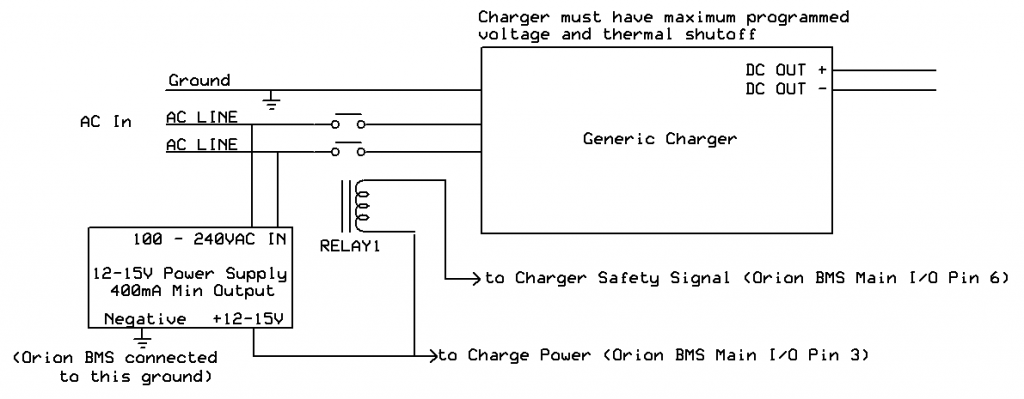Disclaimer: The following information is provided as a guide for integrating the Orion BMS with generic chargers and power supplies. While the information here is believed to be correct, it is the user’s responsibility to verify all aspects of the end application and the suitability of the following. Ewert Energy has no affiliation with other charger manufactures and provides this information for informational purposes only and is not responsible for changes in specifications made by the manufacture. Consult the full user manuals for both products for more information.
The Orion BMS is compatible with almost all battery chargers via an on/off mechanism. When chargers cannot be controlled by CAN or an enable circuit, most chargers can be controlled by interrupting the AC power to the charger. In all cases, the chargers must be programmed with a maximum charge voltage that should be just above the maximum possible voltage of the battery pack to ensure that they will not run away if the AC relay fails. The charger’s internal maximum voltage shutoff is not relied on for normal operation, however it serves as a backup to prevent the pack from becoming severely overcharged in the event of a wiring failure or relay failure. The charger should also be setup to shutoff independently if the maximum pack temperature is exceeded.
Interfacing with a generic charger
For most applications, it is desirable for reasons of extending the battery’s lifespan to charge only to 90-95% state of charge. Unless the battery is being charged at high C rates (the rate of charge verses the amp hour rating of the cells), it should be possible to achieve these charge levels simply by using the charger with constant current in an on/off mode. The following diagram shows the simplest connection:
In this setup, the charger is disabled by default in the event that the BMS is disconnected or fails (fail safe.) When AC power is present, the 12-15V power supply is energized and supplies power to the Orion BMS’s CHARGE power supply input. When the BMS detects power at the CHARGE power supply input, it wakes up and does self checks and tests the battery to ensure it is capable of receiving a charge. When the BMS determines that it is ready to accept a charge, it pulls the charger safety signal to ground turning on RELAY1 in the above diagram. When RELAY1 is energized, the charger receives AC power and begins to charge the battery pack. When the BMS determines that the battery is full or can no longer accept a charge, the BMS shuts off the charger safety signal which then floats high and shuts off RELAY1, turning off the charger by shutting off power to the charger.
Notes about the above schematic:
- The external 12-15V power supply should supply a voltage equal to or higher than the always on power supply for the BMS if it is desirable for the BMS to draw operating current from the AC power supply. A switching mode power supply is recommended.
- The BMS has internal protection to protect against back EMF from the relay coil, though an additional clamp diode can be added if desired for additional protection
- The charger safety signal from the Orion BMS has a maximum load of 100mA (175mA for Rev D and newer.) A relay with a coil less than 100mA (175mA for Rev D and newer) must be used in this application or an amplification circuit must be used (see the wiring manual for more details.)
Note: It is very important that the maximum charger voltage be set just above the maximum pack voltage. This way, if there is a problem with wiring or a problem with the BMS, the charger will shut itself off before the batteries are severely damaged.
Using power supplies as chargers
In some cases, constant current power supplies can be used as battery chargers. Please refer to the product’s manufacture to determine if the power supply can be used for charging batteries. In some cases, it may be necessary to use a diode to prevent the battery from backfeeding the power supply and draining the battery. Some “programmable” power supplies can be remotely current limited by using the 0-5V CCL (charge current limit) analog outputs from the Orion BMS if the power supply supports it. If a 0-5V analog output is used to control a programmable power supply, the charger safety output must also be used in conjunction.
Troubleshooting:
Please see the troubleshooting guide for more information which is available on the Downloads Page.
Important: After making any changes to the charger configuration it is very important to test the setup while closely monitoring the battery pack to ensure that the charger turns off properly at the correct time. It is the user’s responsibility to determine the suitability of the charger.
![]() AN2180 - Copyright (C) 2019 Ewert Energy Systems
AN2180 - Copyright (C) 2019 Ewert Energy Systems

 AN2180
AN2180






